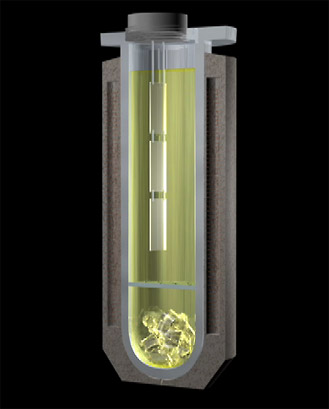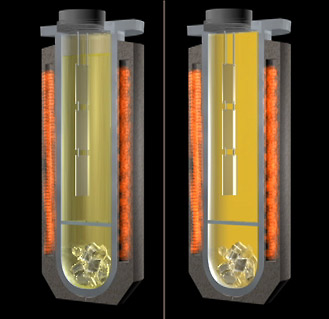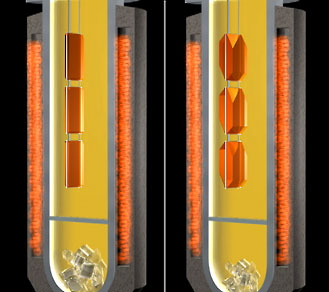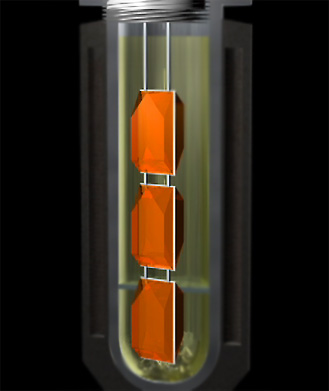
| NEXT Animation >> |
| << PREV Animation |
 |
theimage.com | how to facet | |
| gemstone main | cabochon creation | ||
| min data |
|
| Hydrothermal Quartz Process | |||
| Quartz is grown in a hydrothermal process and moderate temperature but very high pressure. The process uses a thick pressure vessel able to with-stand the high pressure. The vessel is encased in a thermal jacket with heating coils.
Inside the vessel (cut in half view to left) quartz feed material is placed in the bottom. Often high quality broken pieces of natural quartz. A perforated baffle is placed above the quartz feed. The perforation helps later setting up eddies (motion patterns) in the reactive solution. The seed crystals will be suspended from the top and are usually flat plates of transparent (non-colored) quartz. |
|||
 |
A water solution is added to the vessel which contains the colorant material (in this case some Fe (iron) to make citrine. Also a "mineralizer", a little sodium hydroxide or sodium carbonate. (more about this later.)
The liquid is filled to about the 85% level and the quartz crystals are suspended in it. The system is sealed with a high pressure seal. |
||
 |
The mixture is heated. The quartz is very insoluble in the water at lower temperatures. Eventually the water boils creating a liquid - gas phase (first picture). As heating continues the extra pressure caused by the steam formation in the closed raises the boiling point of the water.
As heating continues to around 200 C all of the water has been turned to a gas under high pressure. As the temperature reaches about 300 C the pressure in the vessel is now 20,000 psi (lbs per sq inch). Quartz itself is only slightly soluble at this temperature and pressure, but the mineralizer helps the quartz to form a more soluble sodium silicate. The heating is designed to make a natural 40 C gradient between the bottom and top of the vessel. Thus the lower quartz (feed) is more soluble than the top seed area. |
||
 |
The system is now held in thermal equilibrium. Quartz feed fro the bottom (hotter region) travels up through eddy currents to the top area and is deposited on the slightly cooler seed crystals. A small per centage of iron is also is incorporated in the growth.
Thus the bottom feed quartz is consumed at the to seed crystals grow. A growth rate of about 1 mm per hour creates high quality crystals When sufficient growth time has been allowed, the heating jacket is turned off and the super heated steam one again returns to water. The pressure is lost an they system is opened, the crystals are removed. |
||
 |
They show a distinct clear line where the seed crystals started. and may have small piece of the metal system used to hold them incorporated at their ends.
Citrine is grown by adding iron (Fe+3) to the water solution. Smokey quartz can be created by adding a very small amount of aluminum to the process then irradiating the quartz after the crystals are grown. Amethyst is created by making an almost colorless citrine in the hydrothermal system, then irradiating it after the crystal formation. It too has an iron color center, but the irradiation reduces some it to Fe+2. A synthetic blue quartz (no similar natural material) is produced using Co (cobalt) as the color center. A green quartz can also be produced using iron in the solution under more reducing conditions. Again caused by the presence of Fe+2. |
||
| makingcz2.mp4 | If you would like to see the process animated you may see it here. It is in Quicktime format (mp4 compressor) and is about 7.9 MB in size.
Use the back arrow key to return to this page after playing. |
||